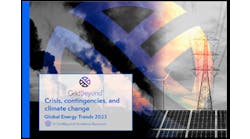Poplar Bluff, MO, 3 x 18 Cylinder, FM-MAN 32/40 Dual Fuel Engine Genset, 6720 kWe @ 720 RPM, Courtesy Fairbanks Morse
Everyone knows what solar and wind energy is. But ask, ‘What is a reciprocating engine generator?’ and most people are stumped. Yet this mainstay technology plays a crucial role in keeping on the lights. We define ‘reciprocating engine generator’ in this excerpt from the new Microgrid Knowledge guide, Reciprocating Engine Generators and Microgrids: The Last Defense Against a Power Outage.
A fixture of the U.S. and international power generation sectors, reciprocating internal combustion engines provide incremental energy almost instantaneously at a relatively low capital cost. This makes them an instrumental part of ensuring reliable and safe flow of power to the grid.
Their dependable responsiveness and ability to run on a variety of fuels makes reciprocating engines mainstays for:
▶▶Providing incremental peaking power to the electric grid during high-demand periods
▶▶Mitigating the ups and downs of solar, wind and other variable-output generating sources
▶▶Ensuring quick-start backup generation in the event of regional or local grid outages
Improve grid efficiency
Reciprocating engines also play a role in improving efficiency on the central power grid.
In particular, they can reduce peak demand on the grid by temporarily generating power for an individual electric customer—or group of customers. This allows the customers to reduce or eliminate their dependence on the grid when it is under strain, often a hot summer day, a period when grid power is apt to be less reliable and very costly.
Reciprocating engines also can be used in combined heat and power (CHP) plants. Highly efficient, CHP channels the engine’s exhaust heat byproduct to useful purposes, such as heating and cooling buildings. The heat would otherwise waft into the atmosphere wasted. Because CHP uses one fuel for two purposes — generating both electricity and heat—it is considered not only an energy efficiency play, but also a way to reduce carbon dioxide emissions.
Ensure reliability and safety
Further, reciprocating engines can provide ‘black-start’ capability—a feature of the technology that plays a vital role in keeping the electric grid safe and reliable. Black start is required when a power plant shuts down during a malfunction or crisis and needs an external power source to help it get started again. During a power outage, the plant cannot rely on the central grid to provide the electricity. So instead the power plant operators turn to on-site diesel reciprocating engines, which can be quickly started to provide the needed electricity.
Reciprocating engines also play another important safety role on the grid, particularly emergency diesel generators. They are often used at nuclear power plants to provide the power needed to safely shut down and maintain the reactor in the event of a loss of normal offsite power, a coolant accident or other operational anomaly.
A reciprocating engine uses the expansion of gases to drive a piston within a cylinder, and converts the piston’s linear movement to a circular (or rotating) movement of a crankshaft to generate power.
There are several types of reciprocating engines, categorized not only by the number of piston ‘strokes’ it takes to complete one combustion cycle (two or four) but by the type of combustion (spark-ignited or compression-ignited) and the fuel—or fuels— the engine consumes.
The four-stroke or four-cycle reciprocating engine is the kind typically used in power generation. The four strokes involved in their operation are intake, compression, power and exhaust The intake stroke expands the combustion chamber within the cylinder and draws in an air/fuel mixture, and the compression stroke compresses the mixture, thereby increasing its energy potential.
With spark-ignited combustion, the air/fuel mixture is ignited by a spark plug, and the burning of the mixture drives the piston through the power stroke. Then, an exhaust value opens and the piston forces out the exhaust gases. With compression-ignited (or diesel) combustion, a higher compression ratio creates extra heat during the compression stroke that ignites the air/ diesel mix on its own, without the need of a spark plug.
As noted above, reciprocating engines can be designed to burn a variety of fuels; some burn only diesel and some are fired only by natural gas. But many are dual-fuel in design, meaning that they can burn either gaseous or liquid fuels.
The capacity of individual reciprocating engines typically ranges from less than 1 MW to as much as 20 MW, and often groups or sets of engines are installed side-by-side so they can be switched on or off as the precise needs of the grid vary. So they can as a group provide 50, 100 or even 200 MW of power. Reciprocating engines installed to provide backup power or to ensure grid reliability generally are switched on automatically when a transfer switch senses a temporary power loss or sudden change in voltage. The engines also can be turned on and managed manually.
Before closing, it’s important to highlight several characteristics that make reciprocating engine generators especially effective as a ‘last defense’ to keep the power flowing during a grid outage. These include:
▶▶Ability to power up quickly (typically reaching full load in five minutes or less)
▶▶Short run-cycle requirements (they can go on and offline multiple times daily with minimal wear and tear)
▶▶Ability to operate at high altitudes and in areas with high ambient temperatures
▶▶Ease in siting because of their relatively small size compared to a gas-fired combustion turbine.
What are the pros and cons of the fuels used in reciprocating engine generators? See Reciprocating Engine Generators and Microgrids: The Last Defense Against a Power Outage, available for free courtesy of Fairbanks Morse Engine.
Energy writer Housley Carr contributed to this article.







